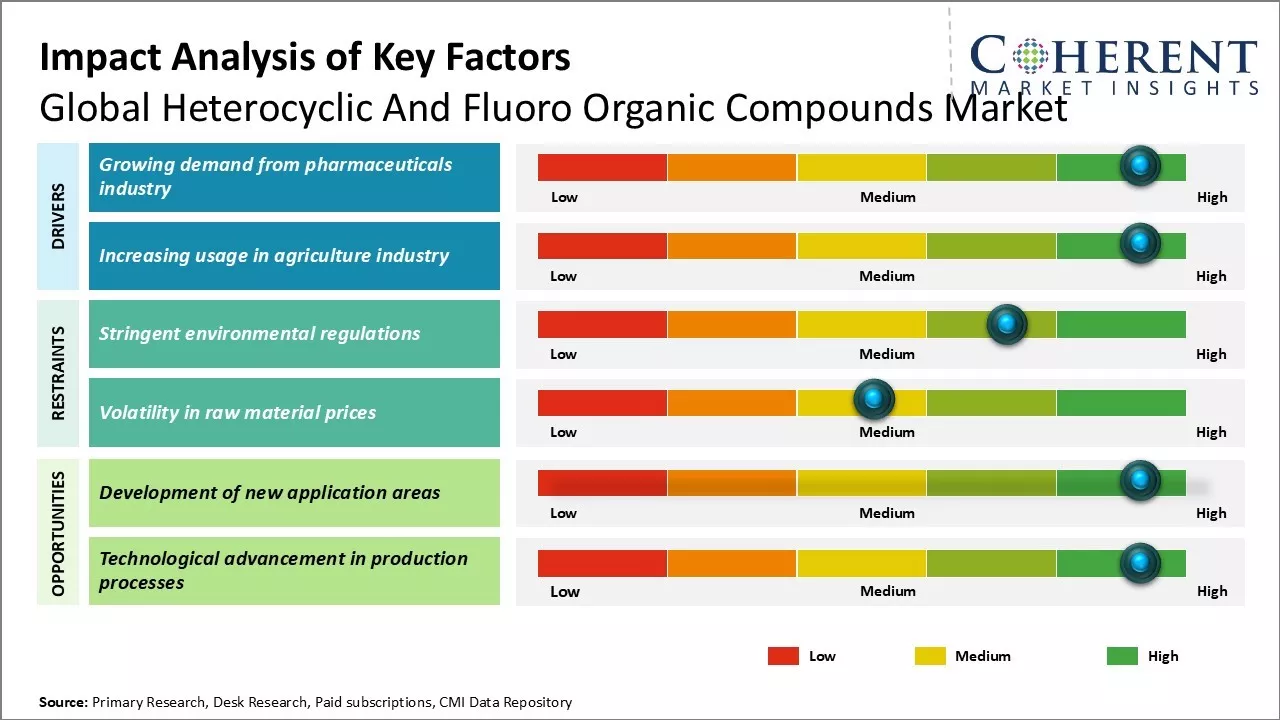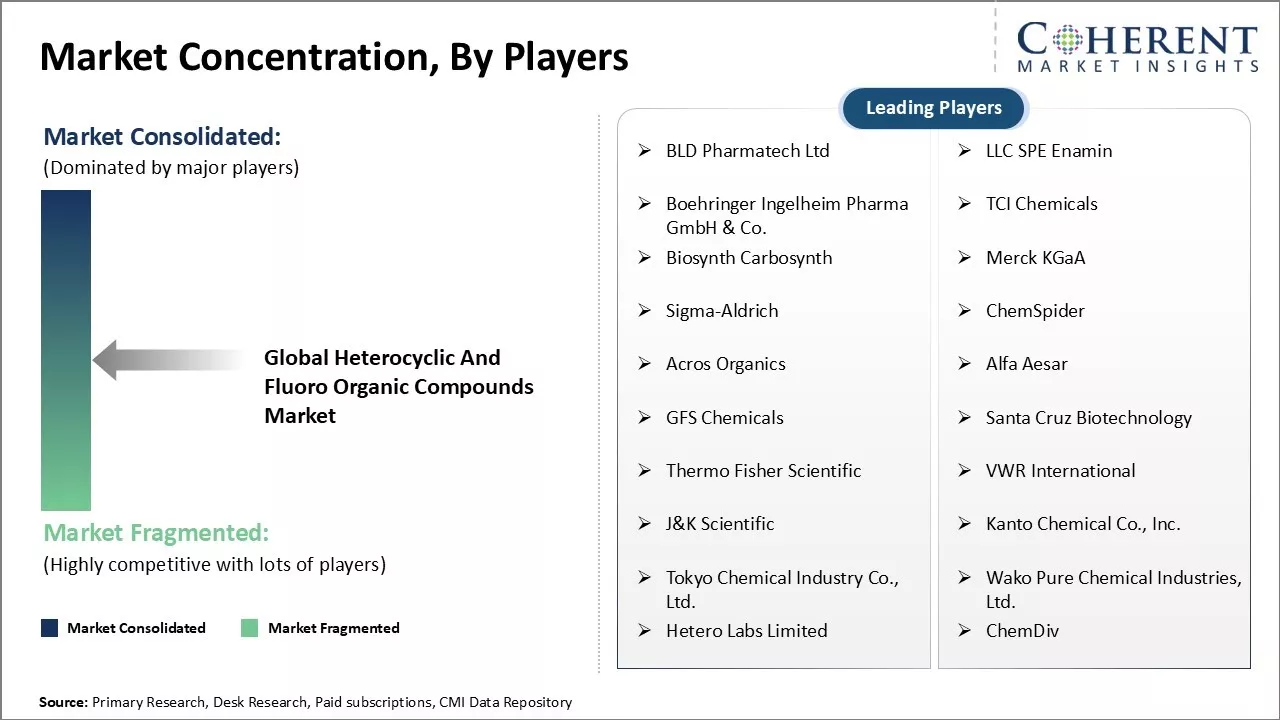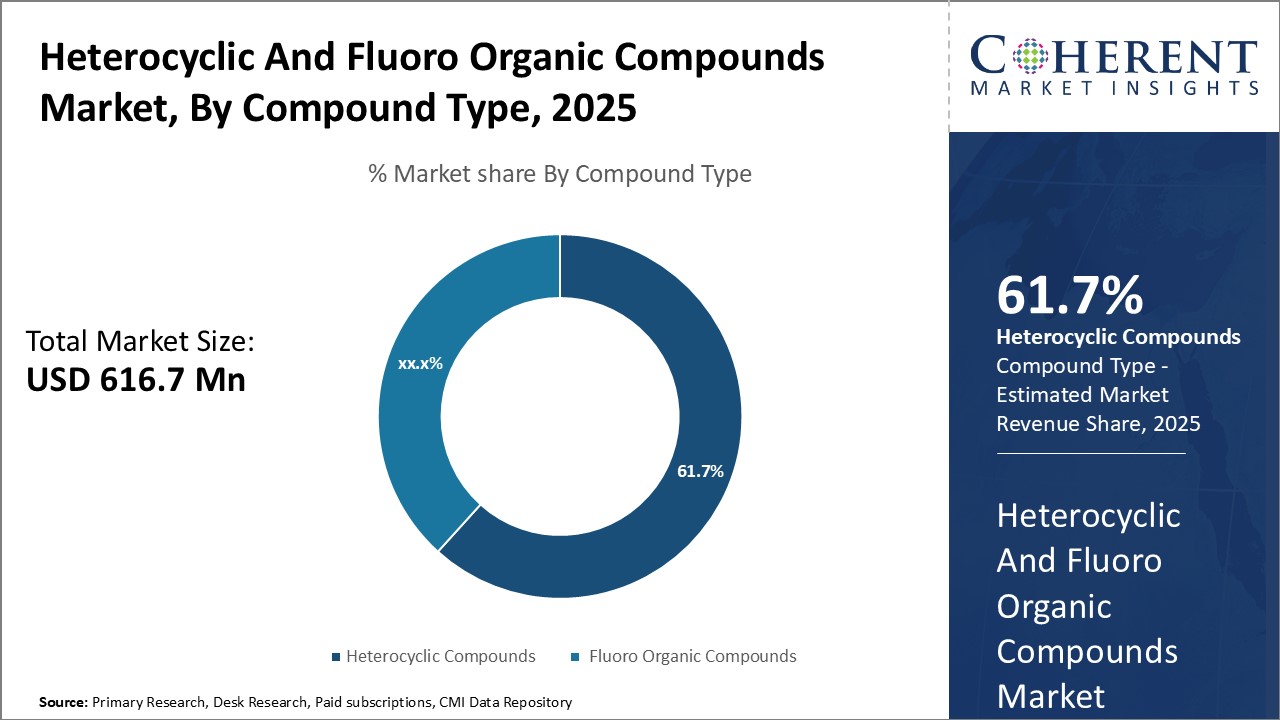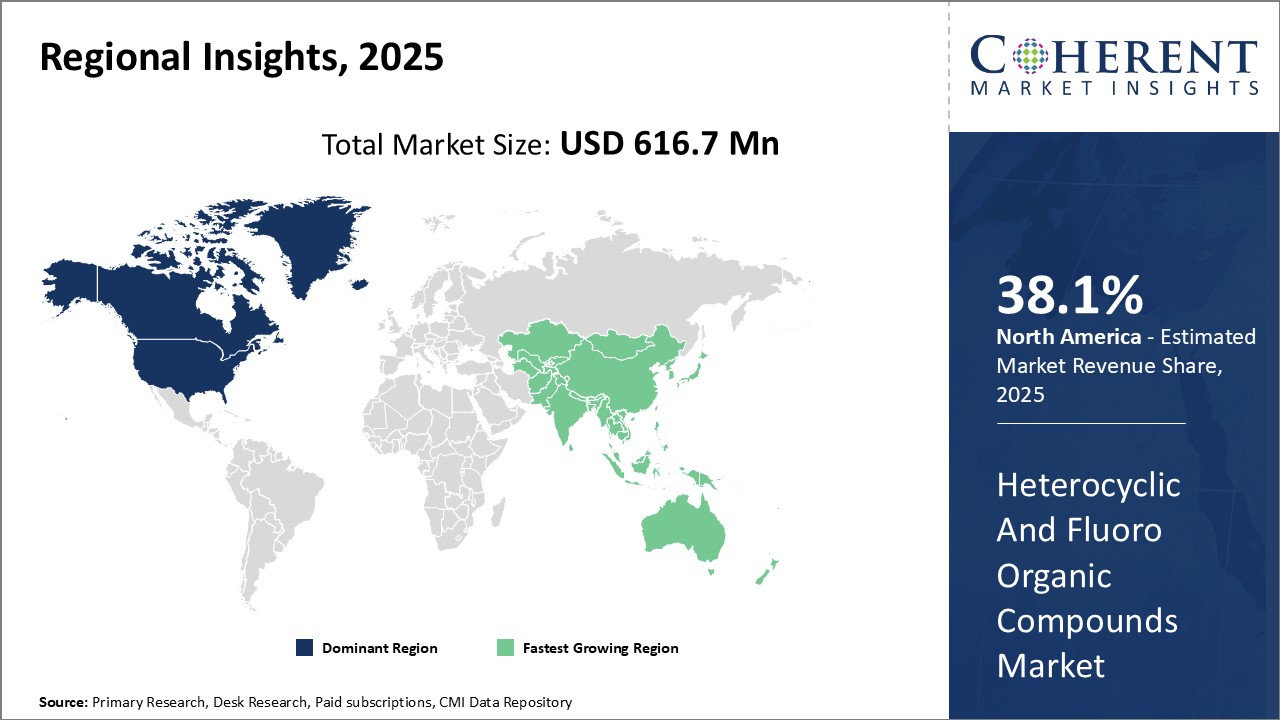Heterocyclic And Fluoro Organic Compounds Market Size and Trends
The global heterocyclic and fluoro organic compounds market is estimated to be valued at USD 616.7 Mn in 2025 and is expected to reach USD 1,017.2 Mn by 2032, growing at a compound annual growth rate (CAGR) of 7.4% from 2025 to 2032.

Discover market dynamics shaping the industry: Download Free Sample
The market has been witnessing steady growth over the past few years driven by increasing demand from various end-use industries such as pharmaceuticals, agrochemicals, and other industrial applications.
Market Driver - Growing demand from pharmaceuticals industry
The global pharmaceutical industry has seen tremendous growth over the past few decades. With advancing medical research and development of new drugs, pharmaceutical companies are constantly exploring heterocyclic and fluoro organic compounds for drug discovery. Heterocyclic compounds contain rings with more than one type of atom and have emerged as important pharmacophores due to their diverse range of biological activities. Many drugs currently in the market contain heterocyclic cores that make them efficacious. Fluoro organic compounds are also gaining significance as fluorine substitution enhances the lipophilicity and metabolic stability of drug molecules.
A majority of new molecular entities approved by regulatory authorities contain heterocyclic and fluoro functional groups. In the pursuit of precision medicines with novel mechanisms of action, pharmaceutical firms are actively screening libraries containing millions of heterocyclic and fluorinated compounds. This screening process identifies highly potent lead compounds for developing treatments against cancer, neurological disorders, cardiovascular diseases, and various other therapeutic areas. Furthermore, drug repurposing activities involve modifications to existing drug structures through incorporation of heterocyclic and fluoro substituents in order to enhance the pharmacological profile. This trend of drug optimization is expected to sustain the demand from pharmaceutical companies.
Clinical trials also involve the synthesis and evaluation of various heterocyclic and fluorinated derivatives of lead molecules to select candidates with optimized pharmacokinetic and safety profiles. As patent cliffs threaten the revenue stream of blockbuster drugs, pharmaceutical giants are investing heavily in R&D to develop differentiated products having heterocyclic chemistry and fluorine substitution at their core. Overall, the need for novel, effective and safe drugs presents a massive market opportunity for heterocyclic and fluoro organic compounds in the pharmaceutical sector.
Market Concentration and Competitive Landscape

Get actionable strategies to beat competition: Download Free Sample
Increasing usage in agriculture industry
The agriculture industry worldwide has relied on heterocyclic and fluorinated agrochemicals such as pesticides, herbicides, and fungicides to boost crop yields for many decades. Chloro and fluoro substituted heterocyclic compounds are widely employed as active ingredients in various agrochemical formulations due to their potency and ability to control pests, weeds, and fungal infections selectively. However, factors such as the emergence of resistance in pests, stringent environmental regulations, and need for higher crop protection are driving agrochemical companies to come up with newer heterocyclic chemistries and optimized fluorinated molecules.
Research indicates that focused library screening programs involving heterocyclic scaffolds effectively deliver novel lead structures with enhanced activity against target pests. For instance, new fungicides based on heterocyclic chemotypes are showing great potential against phytopathogenic fungi that are resistant to earlier generations of agrochemicals. Meanwhile, the addition of fluorine substituents to agrochemical cores improves their chemical and metabolic stability, thereby enabling lower application dosages and reducing residue levels in food crops. This helps agrochemical product developers comply with maximum residue limit regulations.
Considering the projections for global population growth and rising demand for food grains, agriculture outputs need to be significantly scaled up in the coming years. This will spur further innovation in agrochemical formulations relying on heterocyclic and fluorinated active ingredients to address challenges facing modern agriculture. Over the long term, the widespread adoption of integrated pest management practices can also stimulate the diversified demand for heterocyclic and fluorinated compounds meeting stringent safety standards for sustainable crop protection.
Key Takeaways from Analyst:
The global heterocyclic and fluoro organic compounds market is expected to be primarily driven by increasing demand from the agrochemical and pharmaceutical industries. Heterocyclic compounds find wide usage as active ingredients in various pesticides and herbicides. This will drive revenues for companies operating in the agrochemical segment.
Fluoro organic compounds are widely used in manufacturing advanced medicines owing to their unique properties. The rising prevalence of chronic diseases worldwide is prompting increased research and development spending by pharmaceutical players. This will boost the adoption of fluoro organic compounds for developing novel drug molecules.
North America currently dominates the market share due to the presence of a majority of top pharmaceutical companies and crop protection majors in the region. However, Asia Pacific is likely to emerge as the fastest growing regional market. This can be attributed to rising agricultural exports from China and India along with the growing generics industry.
High capital requirements and strong regulations associated with fluoro organic compounds pose challenges for market players. Substitute products may also limit revenue growth opportunities to an extent. Companies need to focus on developing innovative application focused products to counter restraints. Collaborations with end-use industries can further aid in matching supply with evolving demand patterns.
Market Challenge - Stringent environmental regulations
One of the major challenges faced by the global heterocyclic and fluoro organic compounds market is the stringent environmental regulations imposed by various government bodies across the globe. Regulatory agencies are constantly updating and tightening the norms regarding the production, use, and disposal of these compounds owing to their severe harmful effects on the environment and human health. This has increased compliance costs for manufacturers. Meeting the compliance standards requires significant capital investments in upgrading production facilities with advanced emission control technologies. Moreover, obtaining necessary clearances and certifications has also become more complicated over the years. Changing regulations negatively impact the business operations and profit margins of players in the market. Failure to adhere to the prescribed environmental guidelines can attract heavy penalties and even lead to the shutdown of manufacturing facilities in some cases. This acts as a deterrent for new entrants, thereby slowing down the market growth.
Market Opportunity - Development of new application areas
One of the key opportunities for players in the global heterocyclic and fluoro organic compounds market is the development of new application areas. Continuous research and development activities are expanding the scope of uses of these compounds in different end-use industries such as pharmaceuticals, agrochemicals, polymers, and electronics. For instance, researchers are investigating their potential in catalyst applications, optoelectronics, and photovoltaics. Their unique properties make them suitable for specialized applications such as permeable barrier films for flexible displays, protective coatings, and memristors. Growing demand from emerging niche application segments provides tremendous growth opportunities for market participants. Focusing on industrial innovations would help companies capitalize on the market potential. They can also look at acquiring smaller technology firms engaged in developing novel applications. This can help diversify business offerings and revenues.

Discover high revenue pocket segments and roadmap to it: Download Free Sample
Insights by Compound Type: Heterocyclic Compounds Dominate Due to a Wide Range of Applications
In terms of compound type, heterocyclic compounds contribute the 61.7% share to the global heterocyclic and fluoro organic compounds market in 2025. This is mainly attributed to their diverse range of applications across various end-use industries. Heterocyclic compounds contain cyclic structures made of carbon and one or more heteroatoms such as nitrogen, oxygen, and sulfur. The inclusion of heteroatoms imparts increased functionality and reactive properties to these compounds compared to hydrocarbons.
A wide variety of heterocyclic compounds are commercially produced and utilized. Pyridine and its derivatives have applications as solvents and catalysts in organic synthesis and industrial processes. Furan- and imidazole-based compounds exhibit antioxidant and antimicrobial effects and find use as preservatives in pharmaceuticals and food products. Various other heterocyclic compounds act as intermediates in manufacturing agrochemicals, plastics, dyes, and pigments. Some also have applications as corrosion inhibitors and fuel additives.
The versatility of heterocyclic compounds enables their incorporation in diverse formulations. This has led to sustained demand from end-use sectors like the pharmaceuticals, agricultural chemicals, specialty chemicals, and polymer industries. New product development continues to introduce novel heterocyclic compounds with customized properties for emerging applications. As a result, heterocyclic compounds maintain their dominance as the largest compound type segment in the heterocyclic and fluoro organic compounds market.
Insights by Application: Pharmaceutical Industry Drives Adoption as Essential Intermediates
Based on application, pharmaceuticals is expected to account for 36.1% share in the global heterocyclic and fluoro organic compounds market in 2025. This can be attributed to the indispensable need for heterocyclic and fluorinated compounds as intermediates in drug manufacturing.
Heterocyclic compounds constitute a major portion of medicinal chemistry research. They often serve as basic structural frameworks for many active pharmaceutical ingredients (APIs). Properties like metabolic stability, selectivity, and lipophilicity can be modulated by inserting common heterocyclic rings into lead compounds. This allows for the development of highly effective drugs across therapeutic classes.
Similarly, the introduction of fluorine atoms helps optimize pharmacokinetic parameters of molecules. Fluorination improves absorption, distribution, metabolism and excretion (ADME) of drug candidates. It enables the design of formulations with high oral bioavailability and tissue selectivity. As a result, fluoro organic compounds find extensive use as building blocks and intermediates in drug synthesis.
With growing generic competition and patent expiries, pharmaceutical firms invest heavily in the discovery of novel APIs. This drives consistent demand for customized heterocyclic and fluorinated compounds from contract manufacturing and research organizations. Their versatility and efficiency in facilitating drug synthesis has cemented pharmaceuticals as the key application area for these compounds.
Regional Insights

Need a Different Region or Segment? Download Free Sample
North America has dominated the global heterocyclic and fluoro organic compounds market for many years. The region is expected to hold 38.1% of the market share in 2025, owing to a strong presence of pharmaceutical and agrochemical industries in the region. The U.S. plays a pivotal role in driving the regional market growth due to significant domestic demand from the healthcare, agrochemical, and other application industries. Major industry players have their strategic bases in the country and invest heavily in R&D to develop innovative heterocyclic compounds. Additionally, the region also benefits from having a well-established regulatory framework and robust intellectual property rights that encourage continued investments.
The Asia Pacific region is poised to be the fastest growing market in the coming years. China has emerged as the largest producer and consumer of heterocyclic and fluoro organic compounds globally in recent times. This can be attributed to rising investments by international players to leverage the country's large manufacturing base and lower production costs. Further, local pharmaceutical firms are rapidly expanding to fulfill the growing healthcare demands of the rising middle-class population. Other APAC countries like India and Japan are also attracting major investments to strengthen domestic manufacturing capacities and capture high export opportunities. Government incentives to promote generic drugs and agrochemical manufacturing have boosted regional industrial activity.
On the other hand, The global heterocyclic and fluoro organic compounds market continues to be impacted by stringent regulatory norms for product approvals which lengthen the time-to-market for new innovations. However, countries including Germany, the U.K., and France have managed to maintain a strong foothold due to the robust production of active pharmaceutical ingredients. Large investments in R&D allow them to successfully integrate novel technologies for high-value syntheses. Moreover, exports outside the region remain an important revenue source as European products are well sought-after in other developed markets like North America for their quality standards.
Market Report Scope
Heterocyclic And Fluoro Organic Compounds Market Report Coverage
| Report Coverage | Details | ||
|---|---|---|---|
| Base Year: | 2024 | Market Size in 2025: | USD 616.7 Mn |
| Historical Data for: | 2020 To 2024 | Forecast Period: | 2025 To 2032 |
| Forecast Period 2025 to 2032 CAGR: | 7.4% | 2032 Value Projection: | USD 1,017.2 Mn |
| Geographies covered: |
|
||
| Segments covered: |
|
||
| Companies covered: |
BLD Pharmatech Ltd, LLC SPE Enamin, Boehringer Ingelheim Pharma GmbH & Co., TCI Chemicals, Biosynth Carbosynth, Merck KGaA, Sigma-Aldrich, ChemSpider, Acros Organics, Alfa Aesar, GFS Chemicals, Santa Cruz Biotechnology, Thermo Fisher Scientific, VWR International, J&K Scientific, Kanto Chemical Co., Inc., Tokyo Chemical Industry Co., Ltd., Wako Pure Chemical Industries, Ltd., Hetero Labs Limited, and ChemDiv |
||
| Growth Drivers: |
|
||
| Restraints & Challenges: |
|
||
Uncover macros and micros vetted on 75+ parameters: Get instant access to report
Heterocyclic And Fluoro Organic Compounds Industry News
- In 2021, the FDA approved several fluorinated drugs including Scemblix-ABL001 (asciminib), Qulipta (atogepant), Tavneos (avacopan), and Welireg (belzutifan)
- In 2021, Li and co-authors used HFINA to synthesize two F-MOF based on Cu, Cu-FINA1 and Cu-FINA2
*Definition: The global heterocyclic and fluoro organic compounds market is a market that involves the production, distribution and sales of heterocyclic and fluoro organic compounds on a global scale. These compounds contain rings of atoms with at least one heteroatom such as nitrogen, oxygen or sulfur. They also contain one or more fluorine atoms bound to carbon. Key players in this market produce and sell a variety of heterocyclic and fluoro organic compounds that find applications in pharmaceuticals, agrochemicals, polymers and other industries.
Market Segmentation
- Compound Type Insights (Revenue, USD Mn, 2020 - 2032)
- Heterocyclic Compounds
- Pyridine
- Furan
- Imidazole
- Others
- Fluoro Organic Compounds
- Fluoroalkanes
- Fluoroaromatic Compounds
- Fluorinated Polymers
- Heterocyclic Compounds
- Application Insights (Revenue, USD Mn, 2020 - 2032)
- Pharmaceuticals
- Agricultural Chemicals
- Chemical Intermediates
- Polymer Production
- Others
- By Regional Insights (Revenue, USD Mn, 2020 - 2032)
- North America
- U.S.
- Canada
- Latin America
- Brazil
- Argentina
- Mexico
- Rest of Latin America
- Europe
- Germany
- U.K.
- Spain
- France
- Italy
- Russia
- Rest of Europe
- Asia Pacific
- China
- India
- Japan
- Australia
- South Korea
- ASEAN
- Rest of Asia Pacific
- Middle East
- GCC Countries
- Israel
- Rest of Middle East
- Africa
- South Africa
- North Africa
- Central Africa
- North America
- Key Players Insights
- BLD Pharmatech Ltd
- LLC SPE Enamin
- Boehringer Ingelheim Pharma GmbH & Co.
- TCI Chemicals
- Biosynth Carbosynth
- Merck KGaA
- Sigma-Aldrich
- ChemSpider
- Acros Organics
- Alfa Aesar
- GFS Chemicals
- Santa Cruz Biotechnology
- Thermo Fisher Scientific
- VWR International
- J&K Scientific
- Kanto Chemical Co., Inc.
- Tokyo Chemical Industry Co., Ltd.
- Wako Pure Chemical Industries, Ltd.
- Hetero Labs Limited
- ChemDiv
Share
Share
About Author
Vidyesh Swar is a seasoned Consultant with a diverse background in market research and business consulting. With over 6 years of experience, Vidyesh has established a strong reputation for his proficiency in market estimations, supplier landscape analysis, and market share assessments for tailored research solution. Using his deep industry knowledge and analytical skills, he provides valuable insights and strategic recommendations, enabling clients to make informed decisions and navigate complex business landscapes.
Missing comfort of reading report in your local language? Find your preferred language :
Transform your Strategy with Exclusive Trending Reports :
Frequently Asked Questions
EXISTING CLIENTELE
Joining thousands of companies around the world committed to making the Excellent Business Solutions.
View All Our Clients
